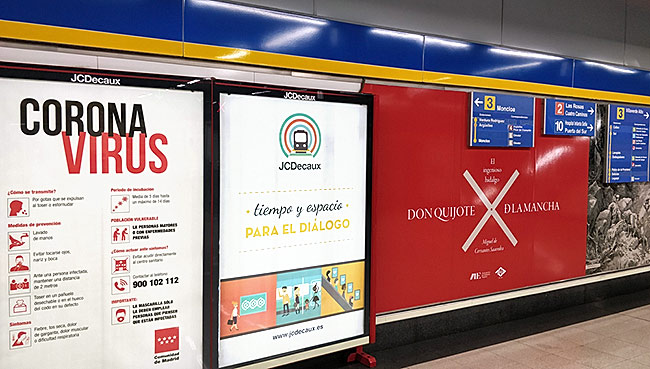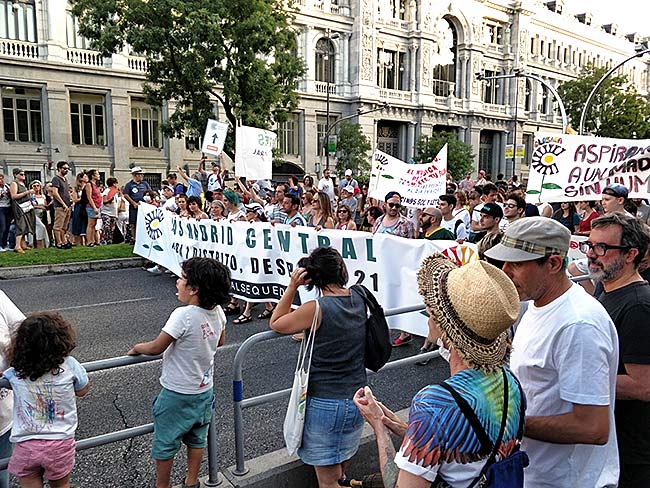I first wore a mask on the Madrid metro on March 3, on the way home from our Tuesday Spanish/English language exchange. This was about four months after the coronavirus emerged in China, and one week after the first cases were diagnosed on mainland Spain. Before the statistics skyrocketed, before the fear set in.
I hadn’t intended to wear it. I’d bought the N95 masks online on impulse, had felt stupid after clicking buy and later had felt guilty, too, after reading about the shortage among health care workers. But I had them now, and the WHO guidelines had said to stay a meter away from the sick, and how could anyone do that on a jammed subway? The northbound 10 metro that I’d ride to the exchange wouldn’t be bad, but the southbound 10 could be a different story. I’d never figured out why any Madrid metro would be so crowded at 20:00 or 20:30 at night, but sometimes it was. Like a sardine can.
So before I left I slipped one of the sealed N95 respirators into the pouch of my pullover. Por si acaso. I hoped I could leave it there. I didn’t want to scare people. By then I’d seen others wearing masks on the metro, but not many.
At the exchange I greeted arrivals with smiles and nods, and sometimes held out chairs, so they wouldn’t notice that I’d stopped offering handshakes and cheek kisses. Participants talked freely about the virus. On March 3 it was still a safe subject for chat among strangers, before the Trump travel ban and the quarantine. Remote, still. Not too personal. Of course, this was murder for small business. Anyone in tourism. Have you been to Gran Vía recently? Doesn’t the foot traffic look lighter now? At least we aren’t in Italy!
I left at 20:00. As soon as I saw the southbound 10 platform at Gregorio Marañón I knew I’d put the mask on. The LCD screen said we still had two minutes to wait, but riders were already queuing four, five, six deep. A delay. Maybe a train had been held up at Nuevos Ministerios or Plaza Castilla for a balky door or a problem passenger or simply because riders couldn’t squirm in and out of the jammed cars quickly enough; for any one of a dozen possible reasons; it didn’t matter; I’d boarded the 10 at this platform at this time nearly every Tuesday and Thursday night for almost two years and couldn’t be mistaken about traffic patterns. The train would be stuffed.
I fished the mask out of the pullover and tore open the cellophane as I strode to the far end of the platform, away from the thickest part of the crowd by the escalators. Trifold, white, eye-shaped, with the plastic respirator valve in the middle. I tugged the elastic bands over the back of my head and fit the lower flap snug under my chin and thumb pressed the metal clip snug to either side of my nose.
The train came. Packed, all right, a sea of heads in every car, with riders’ torsos pressed against the plastic panes of the vertical door windows. When the doors creaked open the nearest riders stepped onto the platform so the riders trapped deep inside could squirm out. I decided not to board. Not with the virus going around. I sat and stared at the gray platform so I wouldn’t have to meet anyone’s eyes and listened to my own clumsy breathing through the unfamiliar respirator.
Another jammed train came and left. Then the LCD said that the next was only two minutes behind. I stood, watched the headlights approach from the tunnel, and when I saw space between the heads in the first coach I knew it would have room for me. I stepped in. Riders slouched against stanchions, the opposite doors, interior walls of the car, heads bowed over smartphones, idly fingering WhatsApp screens, Candy Crush battles. Ignoring me. One young rider’s eyes lingered on my mask with mild interest, maybe a half second. I found a stanchion to lean against and as the doors closed and the train accelerated I tried to breathe so the air would only flow through the respirator. I saw no other masks. I felt like a leper.
A bitterly amusing memory now. As I write, only sixteen days later, Spain ranks fourth worldwide for coronavirus cases, coronavirus deaths. Madrid is the national epicenter; forty percent of the country’s cases and sixty-five percent of the deaths have been here in the capital.

Today masks are all over the city. Surgical masks, construction masks, respirators, whatever people can get their hands on, worn when standing in a deserted lobby, or when striding through open air on an empty block, often in circumstances that make no sense to me. A few days before the quarantine, I met socially with a doctor who chuckled helplessly at the sight of masks misused, tugged carelessly onto foreheads so their owners might smoke, drink, chew hamburgers.
I want to write that the city mood is tense, resigned, frightened. It probably is, but how can I know if I can’t talk to anyone? A quarantine went into effect Monday morning. We can venture outdoors only for necessities: to buy essentials, work (if required or allowed), care for elders. Only alone, not to parks, not to exercise. Schools, restaurants, cafes, bars, barber shops, any and all stores providing non-essentials: all closed. My last social walk was along the Madrid river on Saturday with a fellow expat. A patrol car shooed us away. Restrictions had already been in place then. We hadn’t known.
Since the lockdown I’ve been to the supermarket once for food. Most customers wore masks. Masked staff wielded disinfectant sprays in gloved fingers, cleaning the handles of push carts. I stared wonderingly at a towering mountain of toilet paper.
El Mundo, El País, La Vanguardia, El Diario, Público, ABC, La Razón, El Confidencial all overflow with coronavirus coverage: photos of hospital wards, grim politicians, masked medical staff. El Mundo published two bitter articles (here, here) about the decision to permit the huge 8-M demonstration despite warnings from the UE. Equality minister Irene Montero joined the march, tested positive for coronavirus a few days later. Politicians are portrayed as closing ranks, or as locked in behind-the-scenes conflict. It depends on what you read. I check the Johns Hopkins site and wikipedia page every day to watch the climbing Spain case load and death count.
I presume that the virus will spread more easily in cities most dependent on public transit.
I haven’t read such speculation in the press. Do I have to? In cities like Madrid, Paris, Moscow, New York, millions rely on their urban transit grid for travel. Many never learn to drive; I regularly meet middle-class Madrileños who have never thought seriously of learning how.
If you owned a major media outlet in one of these cities, if you were rich as Croesus and politically hooked in and unafraid of consequences, would you want to publicize the news that your metropolis’ J. Does now court greater risk of contagion or even death because they don’t travel like environmentally profligate SUVers in Dallas? Especially if your op-ed types (with sentiments like mine) have spent the past thirty years regaling those John Does to travel responsibly? Get ready to die, viewers and readers, you poor bastards! Too bad you listened to us!
I don’t have to read it. Ask any experienced straphanger if she, he or it can maintain a one meter distance in public transit at rush hour. Madrid is trying. I read that some published images of packed platforms are false, that post-quarantine ridership has dropped more than eighty percent. The trains I rode in the days immediately before the quarantine were almost empty. But other articles paint a bleaker picture. Much bleaker.
I am reminded of a gambling term: bad beat, for a losing bet on a strong hand. (Who anticipated a once-a-century pathogen?) Or of Maslow’s hierarchy of needs, or the Prisoner’s Dilemma, or of countless apocalyptic novels and movies in which the anti-hero abandons social niceties for guns and survival staples in the face of disaster.

I stand by my views. The pandemic will pass. (Eventually. I hope.) When it does, the personal car will still be one of the planet’s most environmentally destructive products, as it was before the pandemic, as it is today. Built-up European cities will still be ill-suited for cars, as they are today and were before anyone heard of Covid-19. I marched in defense of Madrid Central last year, would march again.
If I were to throw in the towel, buy a car and head for an auto-dependent fort north of Torrelaguna, I’d be honest enough to let you know.
Lead image: Gregorio Marañón station in 2011, CC by 2.0., LWYang

I have not read any reports (in SoCal) about the disastrous Madrid march,
which recalls the similar parade in Philadelphia in 1918. Ironically enough,
that epidemic was labelled “Spanish” flu though it all originated in Kansas City.
People should read more history and less science fiction to see into the future.
And more first–hand accounts by bloggers than reliance on mass media
to learn what is really happening today. Also we must replace mass transit
to office and factory jobs, with mass education and home–based workers.
This is a global revolution, maybe just in time to save the environment.
Thanks for commenting, charles. I heard the march in progress, but wouldn’t have known about the related controversy if I hadn’t read the El Mundo articles.